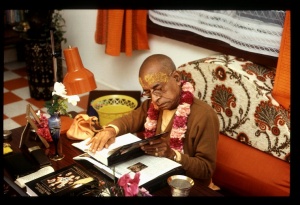CC Madhya 5.140

A.C. Bhaktivedanta Swami Prabhupada
TEXT 140
- bhuvaneśvara-pathe yaiche kaila daraśana
- vistāri’ varṇiyāchena dāsa-vṛndāvana
SYNONYMS
bhuvaneśvara-pathe—on the way to Bhuvaneśvara; yaiche—as; kaila—He did; daraśana—visiting; vistāri’—vividly; varṇiyāchena—has described; dāsa-vṛndāvana—Vṛndāvana dāsa Ṭhākura.
TRANSLATION
[In his book Caitanya-bhāgavata] Śrīla Vṛndāvana dāsa Ṭhākura has very vividly described the places visited by the Lord on the way to Bhuvaneśvara.
PURPORT
In his book Caitanya-bhāgavata, Antya-khaṇḍa, Śrīla Vṛndāvana dāsa Ṭhākura has very nicely described the Lord’s journey en route to Kaṭaka (Cuttak). On that journey, the Lord visited a place known as Bālihastā, or Bālakāṭīcaṭi. He then visited the city of Bhuvaneśvara, where Lord Śiva’s temple is located. The temple of Bhuvaneśvara is situated about five to six miles from Bālakāṭīcaṭi. The temple of Lord Śiva is mentioned in the Skanda Purāṇa, in the narration about the Lord’s garden and the one mango tree. A king named Kāśirāja wanted to fight with Lord Kṛṣṇa, and consequently he took shelter of Lord Śiva to acquire the power to fight the Lord. Being pleased with his worship, Lord Śiva helped him fight Kṛṣṇa. Lord Śiva’s name is Āśutoṣa, which indicates that he is very easily satisfied when one worships him, regardless of the purpose, and he gives his devotee whatever benediction the devotee wants. Therefore, people are generally very fond of worshiping Lord Śiva. Thus Kāśirāja was helped by Lord Śiva, but in the fight with Lord Kṛṣṇa he was not only defeated but killed. In this way the weapon known as Pāśupata-astra was baffled, and Kṛṣṇa set fire to the city of Kāśī. Later Lord Śiva became conscious of his mistake in helping Kāśirāja, and he begged Lord Kṛṣṇa’s forgiveness. As a benediction from Lord Kṛṣṇa, he received a place known as Ekāmra-kānana. Later, the kings of the Keśarī dynasty established their capital there, and for many hundreds of years they reigned over the state of Orissa.